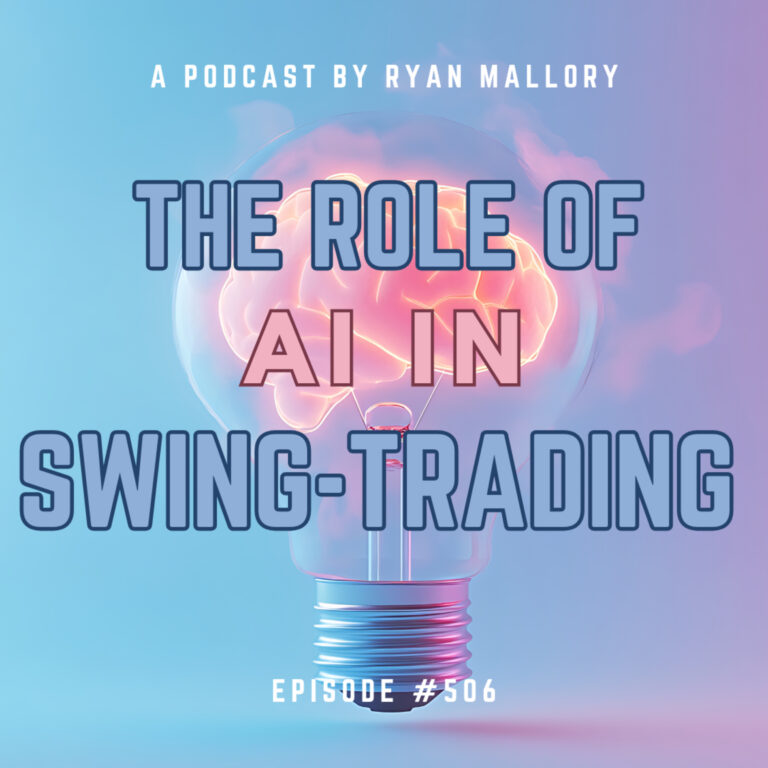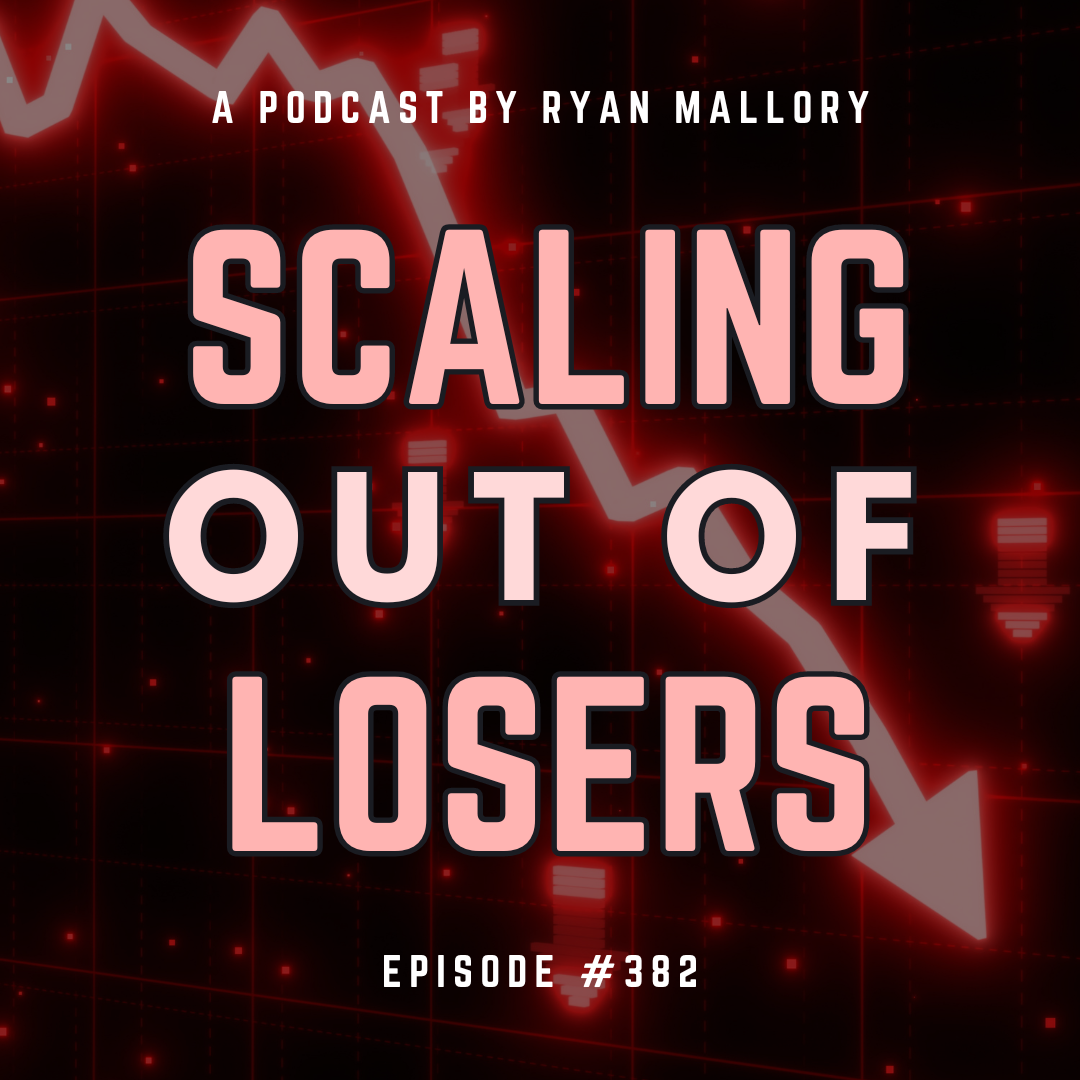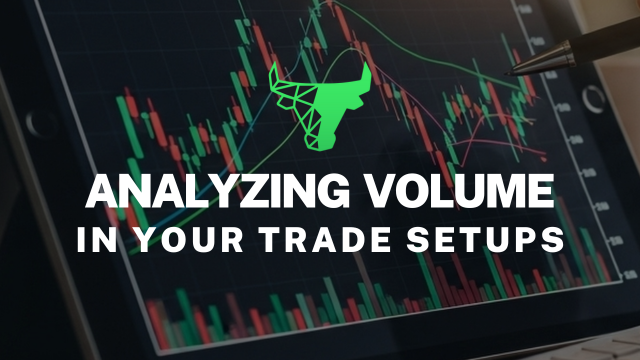Episode Overview
Two questions are tackled in this podcast episode by Ryan Mallory: 1) timing market reversals from a swing-trading standpoint, and 2) scaling out of losing positions to mitigate losses on a trade – what is the best approach for doing so?
Available on: Apple Podcasts | Spotify | Amazon | YouTube
Episode Highlights & Timestamps
- [0:07] Introduction
Ryan opens the episode and previews a discussion about flipping market bias and handling losing trades effectively. - [1:35] Background on Conrad’s Trading
A listener named Conrad shares his trading history, including his win/loss stats and biggest trading challenges. - [3:19] Flipping From Bearish to Bullish
Ryan explains the difficulty in changing market bias quickly and why it’s especially hard in choppy markets. - [5:28] Challenges of Swing Trading Narrow Moves
Ryan outlines why swing trading narrow time frames can make flip-flopping between positions more difficult and error-prone. - [12:21] Scaling Out of Losing Trades
Advice on how and when to reduce exposure in losing trades before they hit full stop-loss levels.
Key Takeaways from This Episode:
- Switching Bias Is Hard: Flipping from bearish to bullish quickly can lead to getting chopped up in volatile or sideways markets.
- Cash Is a Strategy: Sitting in cash is often better than overtrading during market uncertainty. Don’t force trades.
- Shorting Might Not Be Worth It: Ryan questions whether shorting is still a viable swing trading approach, especially in bull-heavy markets.
- Layered Stops Can Help: Use support levels between entry and full stop-loss levels to scale out partially and manage losses better.
- Don’t Ignore the Market’s Message: Avoid stubbornly clinging to a thesis. If the market proves you wrong, adjust before losses pile up.
Resources & Links Mentioned:
- Swing Trading the Stock Market – Daily market analysis, trade setups, and insights by Ryan Mallory.
- Join the SharePlanner Trading Block – Get real-time trade alerts and community support.

Take the Next Step:
✅ Stay Connected: Subscribe to Ryan’s newsletter to get free access to Ryan’s Swing Trading Resource Library, along with receiving actionable swing trading strategies and risk management tips delivered straight to your inbox.
📈 Level Up Your Trading: Ready for structured training? Enroll in Ryan’s Swing Trading Mastery Course, The Self-Made Trader, and get the complete trading course, from the foundational elements of trading to advanced setups and profitable strategies.
📲 Join the Trading Community: Sign up for SharePlanner’s Trading Block to become part of Ryan’s swing-trading community, which includes all of Ryan’s real-time swing trades and live market analysis.
Full Episode Transcript
Click here to read the full transcript
0:07
Hey, I’m Ryan Mallory and this is my Swing Trading the Stock Market podcast. I’m here to teach you how to trade in a complex, ever changing world of finance.
0:16
Learn what it means to trade profitably and consistently, managing risk, avoiding the pitfalls of trading, and most importantly, to let those winners run wild.
0:25
You can succeed at the stock market, and I’m ready to show you how. Hey everybody, this is Ryan Mallory.
0:31
What? Swing Trading the stock market.
0:34
And today’s episode we’re gonna talk about scaling out of losers losing trades. And we’re also going to talk about how to flip your outlook on the market without losing too much money when things change around.
0:46
Most notably, and this is what the focus of this e-mail is gonna be on, will be about the sell off that took place in 2022 and then the subsequent bounce that happened in 2023.
1:04
So with that being said, we got a guy he asked to be called Conrad.
1:12
So this guy asked to be called Conrad and Conrad writes Brian. I have listened to your podcast consistently since November of 2020 and I can’t express how much of a favorable impact you have had on my trading. You’re greatly appreciated.
1:26
There are several different episodes that I have listened to multiple times. I’m a member of SharePlanner’s trading block, so some background information on my trading journey.
1:35
I am 56 part time trader and not planning on going full time for at least three years. My end goal is to make enough trading on an annual basis so that a full time job is not required.
1:46
I’ve been trading for just over 3 1/2 years. I’ve executed 508 trades in that time.
1:53
From September of 2021 through December 2022 I was profitable and up 20%.
2:02
However inconsistent. I was up one month 3 to 5%. The next month I’d be down 2%.
2:05
I journal every trade, I review all trades and my performance month. No trade is entered without a defined risk.
2:12
That is put at a support level. A risk versus return of two is required for entry.
2:19
My general accepted loss is 5% or less. If the trade is a leveraged ETF, I will allow for 7% risk.
2:27
At the end of 2022 and the beginning of 2023 I was extremely bearish and therefore heavily short. Being on the wrong side of the market cost me dearly.
2:35
The drawdown in my swing trading account was 15%. Not only was I short, but totally missed the bull rally.
2:40
Even as the price action was unfolding. I rationalized that the market couldn’t keep going up.
2:45
Obviously, I was wrong. How do I not let this happen again?
2:49
The other issue is that I will stay in a stock that is dropping until my stop is hit rather than scaling out.
2:54
So my questions are this, how should we as traders change our outlook on the market quickly without being indecisive?
3:02
And the second question, how do we decide to scale out of a position that is going in the wrong direction but hasn’t hit our stops?
3:09
You can call me Conrad, which I did. Sincerely, Conrad.
3:12
OK, that was a long e-mail, but pretty good one nonetheless. I mean there’s a lot to dissect here.
3:19
So the first thing I would say is, is that when we get into trying to change our outlooks on the market, one of the things that and and it’s not easy for me either, I I think that when you’re going both long and short on the market, not at the same time. I mean sometimes you can have a, you know long positions and short positions, but let’s just say when you have a bullish outlook versus a bearish outlook, it’s hard to switch between the two and a timely manner.
3:45
It’s just the fact of the matter, 2022, we bottomed out in October, but we had a pretty good plunge there at December 2 after a decent bounce and it looked like that was going to continue into 2023.
3:55
Well, as soon as 2023 starts up, you get a massive rally that really hasn’t looked back ever since. You had like a three months sell off there in the summertime.
4:03
But right now we’re looking at all time highs again. So how do you make that switch?
4:08
So the quicker you make the switch, the more likely you are going to react to smaller movements in the market.
4:15
So if you’re trying to get in and be bullish at the very bottom of the market, that’s gonna be very difficult to do because there’s going to be a lot of back and forth.
4:24
So you’re going to find yourself flipping from bullish to bearish, from bullish to bearish. It’s very difficult just to be bearish when the market’s going down the entire time and just flip it to the bullish.
4:31
Now I do use some like indicators that I think are helpful.
4:35
One of them that I get very nervous about when it starts printing too low of numbers is the T21O8. It’s available through TC 2000.
4:42
You can read any article on my website. There’s a link to it on there and there’s I think it’s also in the notes too for this show.
4:49
And that indicator judges the percentage of stocks trading below the 40 day moving average. Anytime it gets into the single digits, I start to get a little bit leery.
4:56
So last year around like I don’t know, it was probably like August, September, October, November, I started building very, very slowly some long positions.
5:06
I didn’t get as long as I wanted to get, but I did get you know long enough to where it made an impact in my long term positions this year.
5:12
So being able to write out the whole moves from a long term standpoint is much easier because you’re not making as many moves, you’re not booking gains as frequently as you do in swing trading, swing trading, you’re looking at much more smaller moves.
5:20
So just getting, you know, completely bearish and staying bearish for an entire downtrend doesn’t really make sense because you’re going to have some significant bounces along the way. In 2022, when the markets were down over 20%, you still had some pretty big bounces throughout the year.
5:37
You had one in the summertime, you had one off the October lows, they happened and then after those bounces, the market would resume back lower.
5:42
So if you were shortened the whole time, it didn’t really make sense for you to say staying short through those dead cat bounces as a swing trader Now from a long term perspective, yeah, it would. You know, that’s something that you do.
5:55
You have to absorb the hits during these big market sell offs, but from swing trading you can play the different moves.
6:01
The problem with swing trading is that you’re looking at a much more narrower time frame. And so in 2023 when the markets took off in January you had that huge run from January until March and then you had the March regional banking crisis.
6:13
And then after that cleared the air when the Fed bailed out everybody again the markets took off you know back back up to a new yearly highs and then from there you had a three month sell off.
6:20
So then the three month sell off, you know as a swing trader you can play that a little bit but it’s really hard to get right in at the very top and right in at the very bottom and and always know where where those swings are going to take place.
6:35
As a swing trader you’d really don’t want to be you know buying January and holding all the way until now because there’s some pretty decent pull backs that’s going to happen, that’s going to create quite the drawdown.
6:43
Long term position doesn’t really matter, but from a swing trading position it does matter.
6:49
So the quicker that you try to be flipping the script between bullish and bearish based off of what the market’s showing you, the more likely that you’re going to keep reacting to smaller and smaller moves depending on how aggressive you are Now, do I think you can catch all the moves?
7:06
No, I don’t think you can really catch every move. I mean, there’s been moves this year that I’ve definitely missed out on more so to the bullish side, I’ve hit some on the bearish side, I’ve hit some on the bullish side, But there’s some that I regret missing, which I could have done a better job with.
7:13
But it’s very difficult to be able to change your outlook on the markets quickly every time, because I know we don’t want to be indecisive, but sometimes you can be too aggressive too, with changing your outlook to where all of a sudden you’re seesaw and back and forth and you’re just getting chopped up by the market.
7:28
Especially if the market goes into a sideways range and you’re trying to keep flipping the script, you’re gonna be getting long when you should be getting short and short when you should be getting long.
7:36
Now, one way to change that, one way to make it a little bit easier. And I’ve done some podcasts on this.
7:40
And trust me, every day I think more and more about this, you know, and that’s the concept of his shorting dead in the stock market.
7:47
Now there’s days where I truly do feel that way that it is completely dead. But will there be future sell offs?
7:54
Yes. Will there be opportunities to play off of those sell offs?
7:57
Yes. But I also think though, when you’re willing to short stocks, it becomes more of a matter of are you gonna be long, short or in cash?
8:03
Whereas if you only trade to the long side, it’s a matter of are you gonna be long or in cash.
8:09
So there’s only two variables that you’re working with. And it’s a lot easier to scale in and scale out of trades because as the market’s going higher and higher and higher during a good run for your swing trading, you can start taking profits and then when it starts pulling back, you can start decreasing your exposure.
8:23
And as it continues to pull back more, you can go to completely cache. And then when it starts to bounce again, you can start building up that portfolio yet again.
8:31
But then at times when you’re short, you might start seeing the market pulling back and you’re like, OK, this is my queue to get long. Then you’re getting short, then you’re waiting to get stopped out of your shorts while the market continues to push higher.
8:39
So there can be a lot of struggles with that. And that’s one of the things that even I as a trader and here in 2023, I’m thinking more and more about whether or not it’s worth the time to even short stocks. Not that you can’t make money off of shorting stocks.
8:53
But to the flip side, is it worth it to to miss out sometimes on the bigger moves that take place here?
8:59
We got a market that’s sitting at all time highs practically with the NASDAQ and with the S&P 500. Yeah, it might pull back here.
9:05
And then as it starts to pull back, you can get into more cash and wait for the bounces. And in 2022, there was great opportunities to play the balances.
9:13
There was about 3 separate moments in 2023 where there was some pretty good bounce opportunities that you could have written for a combined, you know, two or three months while the rest of the time you’re sitting in cash.
9:22
That’s not a bad place to be when things are going bad.
9:26
And when you look at 2023, it’s definitely a frustrating point if you’re trying to use risk and reward in in your trading.
9:34
Because essentially what 2023 has done is reward anybody that’s willing to put extreme risk out onto the table.
9:41
I always talk about manage the risk. Why do I talk about that?
9:43
Because if it doesn’t work out in your favor, there can be great loss. But that doesn’t mean that people who don’t take massive, massive amounts of risk at times might actually pay you off to take the massive amounts of risk.
9:51
Problem is, if you do that enough times over the course of your life, you’re gonna blow out your account.
9:58
I’ve seen it happen too many times.
10:00
There was a prominent traitor that I’ve seen around for a long time blew out a $7,000,000 account this past week.
10:06
And so if you keep taking big risks, and that’s essentially what happens when you take one risk and it pays off a big risk, I’m speaking of where you’re, you know, putting all your chips into the table and it works, what’s going to happen next?
10:14
You’re going to put all the chips into the table again to try to duplicate that same success.
10:21
And let’s say you get it right again, and then you do it again and again and you get right again and again.
10:25
There’s going to be a time where you’re going to put all the chips into the table and it’s not gonna work out.
10:29
Usually it’s a result of pride coming before the fall. So this was a year where if you said, you know what, I’m tired of managing the risk.
10:36
I’m just gonna put all my chips in the tables, go YOLO on some calls. I’m gonna start buying some same day options, expiration contracts.
10:43
I’m going to just completely YOLO my life away on this market. Guess what?
10:48
You’re probably sitting in an amazing situation right now. It’s paying off now.
10:52
Does that make it the wisest thing that you did? In hindsight, yeah.
10:55
It was a great thing that you did. But if you continue to do that into the future, you’re gonna get your head handed to you.
11:02
I look back into the dot-com era, and I always think back and I think we’re probably in a worse situation than anything we ever saw in the dot-com era.
11:09
This is gonna be like the AI era here, right? What I remember in the dot-com era, so many people I knew, pastors knew, co-workers, a lot of people who had made millions and millions of paper profits, not talking about like they were trading in a paper account.
11:28
They had positions that were millions of dollars, whether it was through Qualcomm options or Sun Microsystems. They don’t even trade anymore.
11:36
They got bought out by somebody, I don’t even remember who. But those people, they had all these millions of dollars and they kept it going.
11:42
Why? Because they were successful by getting extremely risky at one point and they continued and continued it and then they got their heads handed to them. Same thing with like the GameStop phenomenon and others.
11:52
So all these people who are shrugging off risk and just pushing all their chips into the table, yeah, it’s paying in 2023.
12:00
No doubt managing the risk has been a very hard proposition in 2023. When the market just buys every kind of a dip, doesn’t even matter.
12:07
Good news, bad news, we’re going higher. But at some point the roosters will come home to roost.
12:12
And these people who did it one way and made money off of completely throwing risk aside will lose it all, as a matter of fact.
12:21
Now to the second question, how do we decide to scale out of a position that is going in the wrong direction but hasn’t hit our stops?
12:29
I find this one actually a kind of a hard way. If you’re having like a stop loss of like 2 or 3%, sometimes I’ll have a stop loss of two or three percent.
12:35
Is it really worth scaling out of it at that point? Probably not. I mean, you’re taking a 3% loss, you get 6% on the return.
12:42
You know, on a profitable trade, you’re making two to one right there, 9%, three to one, 12%, four to one.
12:48
But if you’re starting to get into like 5% or 6% or 7% losses, yeah, you can scale out of a trade. You know, oftentimes when we put our stop losses at, that’s one support level.
12:57
But between the entry price and the ultimate stop loss, there’s usually other support levels too. So one thing that you can do is you can draw different layers on that trade of OK, if it goes down to here, I’m going to take out a third. If it goes down to here, it takes out another third.
13:09
One of the trades that I remember probably too well this year was PayPal. I got into PayPal.
13:14
It started off and went like 2 or 3% against me. And I went ahead and sold, I think, half the trade and then the stock came back up and I made like 6 or 7% on the trade.
13:22
I made a profit off of it overall, and it was a good trade, but I took half of it out.
13:28
And do I regret doing that? No, no, not at all.
13:30
I mean, I think especially when you look at it now, it just continues to fall since then.
13:37
But that was an example of where, OK, the trade’s starting to go against me. I probably had like a four or 5% stop loss on it.
13:43
And I was at a point there to where things were starting to look pretty grim.
13:47
So I got out of it and then it bounced right back up. It’s not a bad option to do.
13:47
And it’s probably something that I could incorporate more into my trading in general and I don’t.
13:56
But scaling out when the stop loss is really tight might not make as much sense.
13:56
It might be difficult to find one of those like sub support levels in between entry price and the stop loss.
14:03
And so another example maybe when you can scale out too is when you get in, let’s say it’s on a bull flag breakout and it looks pretty good and then at the end of the day there’s a sell off and it starts to go back down inside the bull flag and like crap, wish I didn’t even get into this thing.
14:12
Well, you can sell like half or a third and just see what it does the next day.
14:19
If it continues to fail, if you ultimately get stopped out, at least that stop loss is going to be a lot tighter than what you originally went into it with.
14:25
So scaling out of losing trades isn’t a bad idea either. And if it turns back up and goes back up, hey, at least you didn’t get out of it completely.
14:32
One other thing I would tell you to check out. swingtradingthestockmarket.com.
14:36
Yes, I’m plugging a service here. swingtradingthestockmarket.com.
14:39
You’re gonna get all my stock market research each and every day. That’s going to include daily watchlist.
14:42
It’s going to include watchlist reviews, updates on the big tech, updates on the S&P 500. All sorts of good stuff there.
14:49
I highly encourage you to check it out. In the process of doing so, you’re supporting this podcast.
14:53
I’d also encourage you to leave a five star review. If you enjoyed this podcast or any others.
14:58
That does help out the show quite a bit. Helps me to keep continuing to do what I’m doing and make sure to send me your questions.
15:05
ryan@shareplanner.com I read them all. This guy here, he sent me this question about a week ago, told him I would be putting together a podcast episode for this week.
15:14
So keep sending me your questions.
15:18
I do thrive on having material to work with from you folks. I always appreciate it.
15:24
You guys have been loyal over the years to continue sending me. This is podcast episode 381. So it’s greatly appreciated that you guys continue to support this podcast as much as you have.
15:34
Thank you guys and God bless.
15:40
Thanks for listening to my podcast Swing Trading the Stock Market.
15:48
I’d like to encourage you to join me in the SharePlanner Trading Block where I navigate the stock market each day with traders from around the world.
15:54
With your membership, you will get a seven day trial and access to my trading room including alerts via text, e-mail and WhatsApp.
15:54
So go ahead, sign up by going to shareplanner.com/tradingblock, that’s www.shareplanner.com/tradingblock and follow me on SharePlanner’s Twitter, Instagram and Facebook where I provide unique market and trading information every day.
16:07
If you have any questions, please feel free to e-mail me at ryan@shareplanner.com.
16:15
All the best to you and I look forward to trading with you soon.
Enjoy this episode? Please leave a 5-star review and share your feedback! It helps others find the podcast and enables Ryan to produce more content that benefits the trading community.
Have a question or story to share? Email Ryan and your experience could be featured in an upcoming episode!
Become part of the Trading Block and get my trades, and learn how I manage them for consistent profits. With your subscription you will get my real-time trade setups via Discord and email, as well as become part of an incredibly helpful and knowledgeable community of traders to grow and learn with. If you’re not sure it is for you, don’t worry, because you get a Free 7-Day Trial. So Sign Up Today!

Welcome to Swing Trading the Stock Market Podcast!
I want you to become a better trader, and you know what? You absolutely can!
Commit these three rules to memory and to your trading:
#1: Manage the RISK ALWAYS!
#2: Keep the Losses Small
#3: Do #1 & #2 and the profits will take care of themselves.
That’s right, successful swing-trading is about managing the risk, and with Swing Trading the Stock Market podcast, I encourage you to email me (ryan@shareplanner.com) your questions, and there’s a good chance I’ll make a future podcast out of your stock market related question.
AI is quickly overtaking our everyday life, and in the process changing how we live our life too. But how does AI impact swing trading and what can we use AI for in order to better enhance our trading returns, and perhaps make it a little bit easier too? In this podcast episode, I cover how AI is impacting swing traders, and what it means for the stock market going forward.
Be sure to check out my Swing-Trading offering through SharePlanner that goes hand-in-hand with my podcast, offering all of the research, charts and technical analysis on the stock market and individual stocks, not to mention my personal watch-lists, reviews and regular updates on the most popular stocks, including the all-important big tech stocks. Check it out now at: https://www.shareplanner.com/premium-plans
📈 START SWING-TRADING WITH ME! 📈
Click here to subscribe: https://shareplanner.com/tradingblock
— — — — — — — — —
💻 STOCK MARKET TRAINING COURSES 💻
Click here for all of my training courses: https://www.shareplanner.com/trading-academy
– The A-Z of the Self-Made Trader –https://www.shareplanner.com/the-a-z-of-the-self-made-trader
– The Winning Watch-List — https://www.shareplanner.com/winning-watchlist
– Patterns to Profits — https://www.shareplanner.com/patterns-to-profits
– Get 1-on-1 Coaching — https://www.shareplanner.com/coaching
— — — — — — — — —
❤️ SUBSCRIBE TO MY YOUTUBE CHANNEL 📺
Click here to subscribe: https://www.youtube.com/shareplanner?sub_confirmation=1
🎧 LISTEN TO MY PODCAST 🎵
Click here to listen to my podcast: https://open.spotify.com/show/5Nn7MhTB9HJSyQ0C6bMKXI
— — — — — — — — —
💰 FREE RESOURCES 💰
— — — — — — — — —
🛠 TOOLS OF THE TRADE 🛠
Software I use (TC2000): https://bit.ly/2HBdnBm
— — — — — — — — —
📱 FOLLOW SHAREPLANNER ON SOCIAL MEDIA 📱
*Disclaimer: Ryan Mallory is not a financial adviser and this podcast is for entertainment purposes only. Consult your financial adviser before making any decisions.





